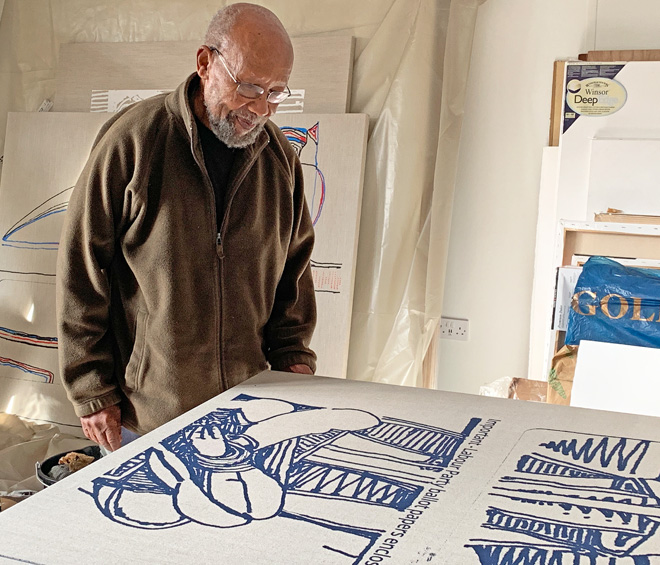
by ANNA McNAY
While the main part of Saatchi Gallery, London, is closed for installation, I – somewhat ironically – pop along to visit Pain Relief, a one-room exhibition by the Oxford-based, Sudanese artist Ibrahim El-Salahi (b1930). I say “ironically”, since, thanks to a sprained ankle, I am on crutches and have to hobble up and down numerous staircases, taking the back entrance to the gallery – rendering my own myriad forms of pain relief less than adequate. Nevertheless, the end goal is worth it: a splendid 13 large canvases – mainly monochrome in black and white, with some blue and red – depicting abstracted figures, some quite Arabic, some more western and Paul Klee-like, and others appearing to grow roots, stretching far into the ground on which they stand, asserting their physicality and corporality.
The canvases – unique monoprint paintings – have been transferred through silkscreen gauze from El-Salahi’s small-scale drawings in pen and ink, made on the inside of the packets of medications the 88-year-old artist takes for sciatica and chronic back pain. Fourteen of these original drawings are on display in a vitrine, looking at first glance like intricate doodles in comparison to the much more minimalist and bare large-scale canvases.
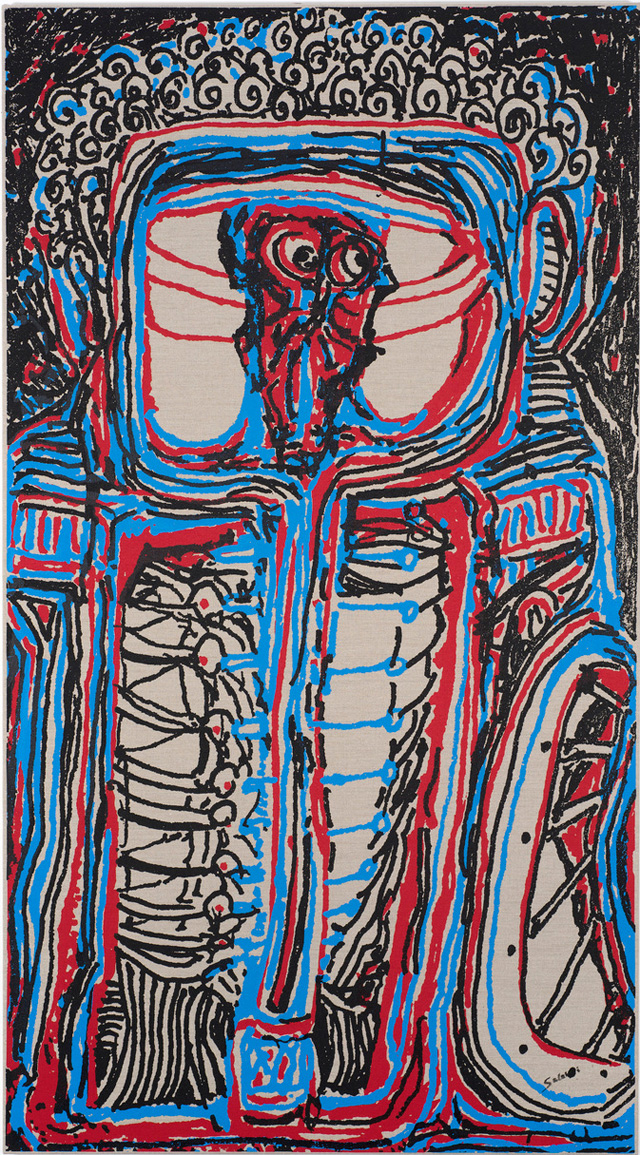
Ibrahim El-Salahi. Pain Relief, 2019. Monoprint on calendered Belgian linen, 201 x 111 cm (79 1/2 x 43 3/4 in).
My own favourite, Pain Relief (2019) – on display in both forms – is a blue, black and red work, depicting a head and torso, with the rib cage detailed to show each joint and its connection to the spine. On the righthand-side, a wheel-like construction, and, at the top, squirls and swirls, symbolise, for me, the concentrated, continual cycle of chronic pain.
In an essay in a new publication on Francis Bacon, Semir Zeki, a professor of neuroaesthetics, discusses the brain’s privileged facility for recognising bodies and faces in preference to other objects, even when they are distorted or mutilated. He also acknowledges our unconscious ability to read the emotion of fear.1 These observations seem to more than carry over to El-Salahi’s work, with its uncomfortable, discomfited figures and the emotion, or feeling, of pain – recognisable universally and instinctively.
I spoke to El-Salahi by email as he prepared for the exhibition.
Anna McNay: You have described the act of making these drawings as a form of meditation. Is it the act of drawing, the fact that it is something you have been devoted to your whole life, and proving to yourself that you are still able to do it, that eases the pain, or is it that you become so absorbed that your mind is taken away from the pain?
Ibrahim El-Salahi: It’s that when I am drawing, my mind is concentrated and I can forget about the pain.
AMc: Are you in pain at the point when you begin each drawing? How long does it take for the pain to subside?
IES: It’s a mental thing – when I concentrate, my mind goes from the pain to what I am drawing. Drawing for me is a kind of meditation.

Ibrahim El-Salahi. Pain Relief Drawing, 2019. 12.5 x 10 cm (4 7/8 x 3 7/8 in).
AMc: Do you never find yourself making the pain worse by sitting and working at your drawings for prolonged periods, or do you become aware of the need to move?
IES: No, I would stop if it got worse instead of better, but my experience is positive.
AMc: Do you begin a drawing with an image or concept in mind, or does the pen lead the way?
IES: No, but images enter my mind and flow through to my fingers. Something will start me off, the pattern and indentation of the braille [on the medication packet], a memory or something that jumps into my head.
AMc: Does the nature of the packaging you are drawing on influence the content or outcome of the drawing? So, for example, do certain painkiller packages trigger one type of idea or imagery, and another kind of medication another type of imagery? How about when you draw on envelopes? Are these not “blanker” canvases, less imbued with narratives of their own?
IES: Yes, for sure – the shape, where the folds are, the braille, etc, but it’s the scale and convenience that suits me both physically and creatively at the moment and frees me creatively and from the pain. This is not a project that had to all be on painkiller packets – the truth is there are lots of them, so they are the first thing to hand if I want to keep working. However, old envelopes and other small bits of discarded paper do the trick also. In envelopes I see images that relate to the stamps or advertising. The printed dots remind me of elements of my drawings, and I use the information as a starting point. They are also containers of information and messages.
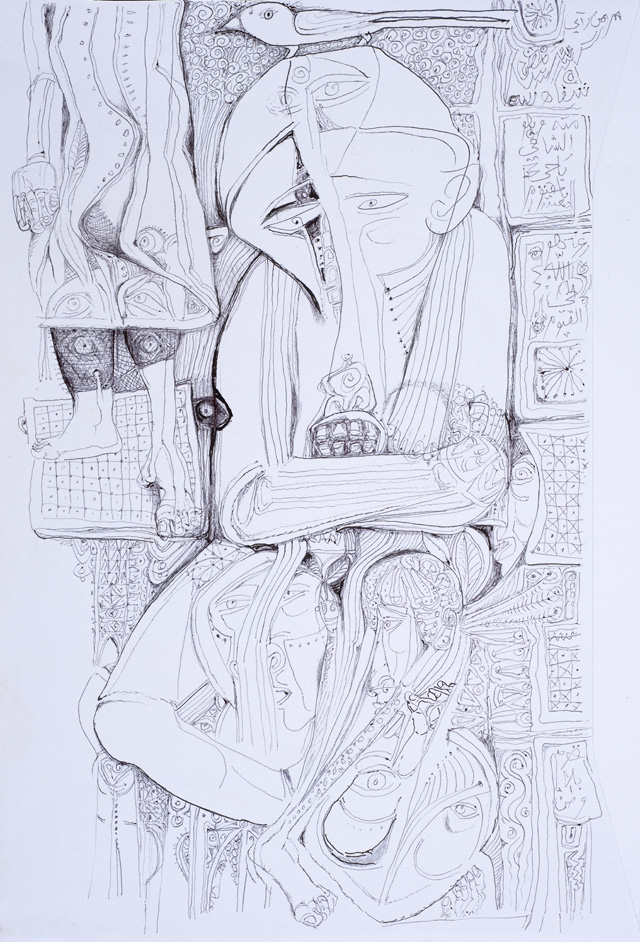
Ibrahim El-Salahi. Pain Relief Drawing, 2018. Pen and ink on a paper envelope, 28.6 x 20 cm (11 1/4 x 7 7/8 in).
AMc: The figures in some of the more figurative drawings look as if they are in pain. Are they reflections of yourself and your own pain, or of something wider?
IES: Yes and no. I often incorporate images from suffering past and present, personal or general, but these works are not, for the most part, literal. It’s about the act of drawing offering respite, not drawings about pain, although there are exceptions, for example Pain Relief (2019), which is a self-portrait. The subjects are as varied as my mind and my history and memories. They can be very positive, happy as well as sad. There is no overriding theme. However, I have been thinking also about how they will look when they transform in scale and how the internal nature of some becomes more powerful when amplified in scale.
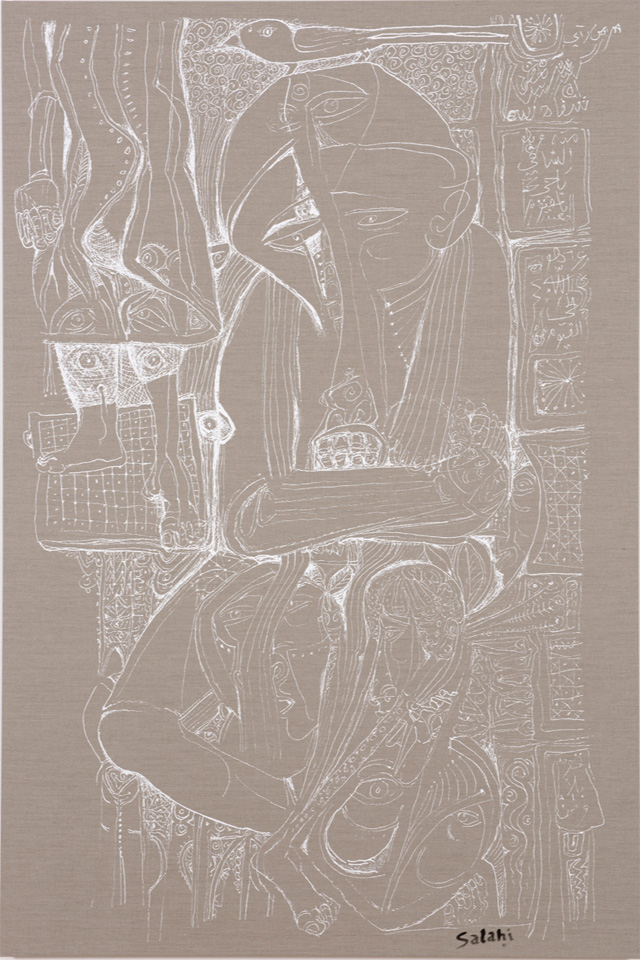
Ibrahim El-Salahi. Pain Relief, 2019. Unique silkscreen on calendered Belgian linen, 196 x 130 cm (77 1/8 x 51 1/8 in).
AMc: How and why do you incorporate textual or calligraphic reference into the drawings?
IES: Through using the braille or stamped imagery to tease out images, or as starting points, and through the influence of the calligraphic lines and shapes that have been a constant source of inspiration since the late 1950s. However, in the Pain Relief works, the use of calligraphy appears more where the shape of the packet reminded me of the prayer boards I grew up with. Books and writing have always been important to me, whether my own writing or others ancient and modern.
AMc: You have spoken of how making these images reminds you of the small-scale drawings you made on scraps of cement casings when you were a political prisoner in the 70s in Sudan. Is this purely a size thing, or is there something about what you are drawing, or what you are feeling, that resonates?
IES: It was a means to an end and because of my personal situation. It is the same now with these Pain Relief drawings and canvases. In prison, it was an internal thing, and now it’s a way to reach out and communicate – yet still coming from an intimate personal space. Like the Time Waste Palace drawings in the Sharjah Art Foundation, my work often reflects my resources and circumstances alongside my thoughts, dreams and memories.
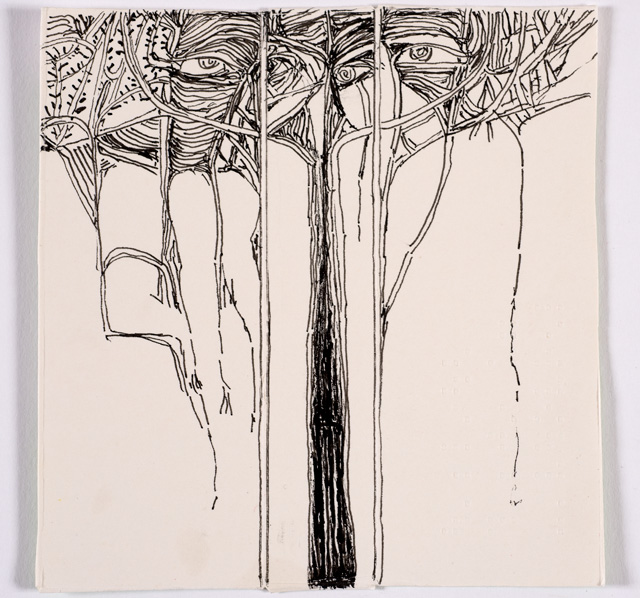
Ibrahim El-Salahi. Pain Relief Drawing, 2019. Pen and ink on the back of a medicine packet, 12.5 x 12 cm (4 7/8 x 4 3/4 in).
I learn from what I do, so past works, or writings, become part of me and my source material. So, yes and no. It is a size thing because scale has made it possible or easier to achieve, a practical possibility. On the other hand, there are sometimes associated feelings and memories relating to my time in prison and other experiences personal and shared.
AMc: While recognising these small drawings as works in their own right, you are also using them to make larger, monoprint paintings. Can you explain a little about this process? How are the drawings being scaled up? Is this something you are capable of, or does someone else assist, using your initial works?
IES: I do the drawings. They are scanned and transferred to acetate. The image is then burnt into a silkscreen and paint is pushed through the mesh to make the image. Sometimes, there are several different colour variations as well as black and white and each reacts differently to the linen. Thus, each one is unique.
For me, scale can be transformative. I wanted to make these works be seen and to transform them so that the public or viewer is able to share them and react to them. I asked Toby [Clarke], the director of the Vigo Gallery, which represents me, to help me achieve this either on canvas or by projection. He understood what I was trying to achieve and helped me research material and found a brilliant printer called Mark Jenkins at K2, who understood the project, and between the three of us we tested different materials and techniques, settling on making unique screenprint works on canvas. I also made etchings a couple of years ago with Paragon Press, which I enjoyed enormously, and this got me thinking about how the image can transform from one surface to another. My prints have traditionally been very experimental; unique zincography and etchings were typical of my experiments in the 50s, 60s and 80s. I also like the idea that these works can be more affordable and available for museums and collectors, opening up who may be able to access them. So far, the Ashmolean Museum and the National Museum of African Art at the Smithsonian have bought works, and several other collections are interested, which is a nice reaction.
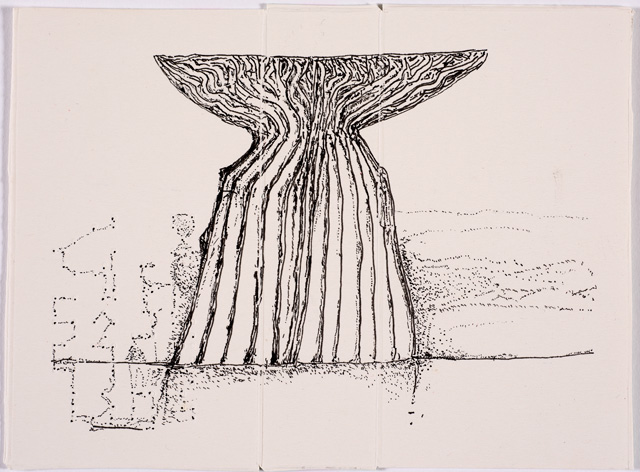
Ibrahim El-Salahi. Pain Relief Drawing, 2018. Pen and ink on the back of a medicine packet, 11.5 x 15.5 cm (4 1/2 x 6 1/8 in).
AMc: Do you have a preference for the small- or large-scale?
IES: I built a new studio to make big paintings at my house in Oxford. The planning took a long time and I found myself unable to use it because of my health by the time it was ready. I was also limited by the council to a reduced head height as we are on a floodplain. This was a way I could make the big works I wanted to make. Ironically, I have been so inspired by seeing the drawings transformed since then that I have been in the studio almost every day and I have slowly started work on a large, two-metre painting, which I am very excited about, but I need a cherry picker if anyone has one!
I have always enjoyed the intimacy of paper and its suitability for the medium of pen and ink and the drama of canvas, but really, since the run-up to the shows at Sharjah Art Foundation (2012) and Tate Modern (2013), I have been interested in scale. I have been inspired to add to the very few works I have made during my career on a large scale – there are only six large paintings from before this series and five of them are in museum collections, so I hope this gives more people access to my work on a different scale.
AMc: Your work, on the whole, has always stemmed from something or somewhere quite intimate and personal. What drives you to share your pain, in this instance, with others? Do you want to make people realise what is still possible, in spite of suffering? Or is it purely something you are doing for yourself, which now happens to attract attention because of your status?
IES: I do the works for myself, but am very happy when people see them and find something interesting. The audience completes the artwork. I want to communicate.
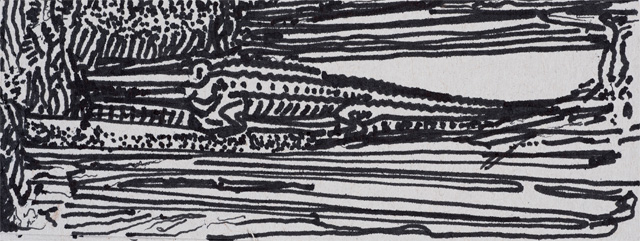
Ibrahim El-Salahi. Pain Relief Drawing, 2018. Pen and ink on a paper envelope, 4.3 x 11 cm (1 3/4 x 4 3/8 in).
AMc: As someone with chronic pain and illness myself, I was very ambivalent about the recent Frida Kahlo exhibition at the V&A, London. I felt it was trespassing on her privacy and posthumous peace to put out all those medication packets for people to gawp at – even though she was open and honest throughout her life about her suffering. Perhaps the display of her self-decorated casts and boots was a little different, though, as these she had turned into art. Do you feel any resonances here, or do you merely see your packaging as material on which to work? Do you want your legacy to also talk about your pain and suffering, strength and endurance?
IES: The medicine packets are on the back of the images, so can’t be seen. This is just how the works came to be. I am not asking people to consider my suffering or endurance, just the imagery that comes out of it. In that sense, the packets are material to make work. Unfortunately, I did not see the Frida Kahlo exhibition.
AMc: Do you ever return to a drawing? How do you know when it is finished?
IES: It has been the case over many decades that some drawings take many years to finish. They let me know if they are not finished.
AMc: You’ve made around 180 of these drawings now. Do you see them as a series, and is the series complete? What about the large works following from them? Will there be more of these?
IES: I’m not sure, but I think I have finished the drawings. However, some series I come back to, and some every 20 or so years – there have been three in the series Reborn Sounds of Childhood Dreams; the first is at Tate Modern and was made in the 60s, and the last was made in 2016.

Ibrahim El-Salahi.
I occasionally find that I mislaid some of the Pain Relief drawings, but, as I said, I am now back in the studio working slowly but surely. So, in that sense, I have been helped physically as well as mentally by this series as there is no way I would have been up to it three years ago. This is a very good way for me to enjoy making work, so I imagine I will do more drawings on this small scale.
The process of creating the works on canvas is long. I do the drawings. I look through them with Toby. He takes them back to London, where they are transferred to the screen, then the canvas. It is then sent to be stretched and subsequently comes down to me in Oxford where, if I am happy, I sign it and it becomes part of the series. It goes back to London to be photographed and documented. The whole process may take many months, if not years. We have saved some work so that venues overseas can have shows that are different from this one.
AMc: What is next for you after this exhibition?
IES: I am working on a book of drawings relating to what I see on the news. I am also working on that large painting. The Pain Relief series is still in its early stages. There are many images and they take a long time to make.
Ibrahim El-Salahi: Pain Relief is at the Saatchi Gallery, London, until 18 July 2019.
References
1. The Visual Shock of Francis Bacon: An Essay in Neuroesthetics by Semir Zeki and Tomohiro Ishizu. In Bacon and the Mind: Art, Neuroscience and Psychology, edited by Martin Harrison, published by the Estate of Francis Bacon Publishing in association with Thames & Hudson, 2019, pages 120-147.